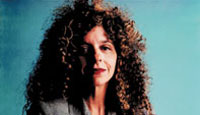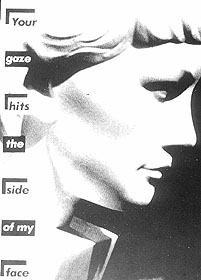
¡@
Links:







Barbara Kruger
Kruger was born in New Jersey in 1945, an only child in a lower middle class family; her dad a chemical technician and her mum was a legal secretary. In 1965, Kruger began classes at Parson School of design where she concentrated in the fine arts program. The way of teaching was very conservative but was lucky to have Diane Arbus and Marvin Israel as teachers as they played a major influence to her career. Arbus was a significant female artist who was also one of the few who was able to expose the complex, seamy underside of suburban life. Although out of the two teachers Israel had a more dominating influence on Kruger. Israel was a note graphic designer and art director of Harper¡¦s Bazaar in the early 1960¡¦s. He took a personal interest in Kruger and introduced her to photography and exposing her to the magazine role. Later on Israel encouraged Kruger to produce a portfolio, which she took to Condé Nast publications where she was given a job at Mademoiselle, a magazine. With in a year, she was promoted to head designer and began freelance work designing covers for books that was generally on political text. The experience in fashion magazines advertisements, Kruger found the ability to ¡¥hail¡¦ and engage the viewer, forcing attention to an image¡¦s innuendo. A technique that impacted on Kruger¡¦s art making practice.
Not only has she been influence by her teachers and her pre-art career, she is also influenced by the world around her. Kruger¡¦s key influence, she quotes, can be found in movies, television and the stereotypical situations of everyday life. She also describes her experience as a graphic designer as ¡§ the biggest influence on my work¡¨. She also states that graphic design became her work which a few adjustments as an artist. The experience impacts on her work on two levels:
- Level of procedures: evident in the appropriate selection of images and adjusting them to size, cropping dimensions to focus on the visual impact.
- Strategic level, manifest in advertising¡¦s choreography of seduction, or what Kruger defines it as¡¨ brand of exhortation and entrapment¡¨.
Later on, Kruger became associated with a group of artist of her time, including Barbara Bloom, Ross Bleckner and Jenny Holzer, amongst others who where developing what Kruger calls ¡§a vernacular sort of signage¡¨. They where all influenced by French theorists such as Jean Baudrillard, author of The Culture of Consumption, who wrote that the modern life was all about images and surface appearance.
All these influences reflect upon Kruger¡¦s work and her art-making practise. Typically large, her works incorporate photographs taken for m different media sources that she has cropped, enlarged and juxtaposed with strident verbal statements of phases in the imperative language of advertising and propaganda. Kruger uses her trademark colours red, black, and white, to highlight the concerns centralising her art works as well as capitulating the eye of the audience. Kruger¡¦s art also exhibits other features that are conventional to the post-modern practise. She develops images by reproducing other images, appropriating the media¡¦s clippings so as to extend and amplify their rhetoric. These manipulations elude aesthetic categorization, as they do not lodge easily with the established traditions of posters, art photography and so on, hence in the challenging manner of the post-modern. Another characteristic of the post-modern Kruger displays is that she merges images and words, multiplying media and annexing concepts from other disciplines, things that diverge from the ways of art conventions.
Kruger¡¦s practise reflexes the discovery, evident throughout contemporary art, of the formative power of images, the capacity of signs to affect deep structures of belief. Her art is concern with the positioning of the social being, with the ways in which our thoughts, attitudes and desires are determined by social trends that the media dictates. Using her arsenal of visual devices, Kruger proposes to intervene in stereotypical representations, disrupting their power, unbounding their hold and replacing it with space for enlightened awareness. Her art is present in multiple sights through which signs circulate or mobile, producing books, posters and billboards as well as popular consumer objects such as t-shirts and matchboxes or even wrapped around a bus.
Although Kruger has developed her own stylistic characteristics, it was a gradual process in finding them. Her early pieces where large woven hangings, pertain more to crafts and to a kind of feminist work. The stitching, crocheting and weaving in this art reflected on what was known as ¡§ conventional women¡¦s work¡¨ or as Kruger notes, activities which where ¡§allowed¡¨ to women to express there inner ability. Her stitch-and- glitter-encrusted-painting, 2 a.m. Cookie, was included in the Whitney Biennial in 1973.This was the establishment of her reputation in the art world. From then she had two one-person exhibitions in New York, the first at the alternative gallery Artists¡¦ Space in1947, the second at the Fischbach Gallery in 1975.
Later on she was troubled by the work¡¦s detachment from her life and from the social and political issues, which was her growing concern. The radical thinking of the ¡¥70¡¦s required the sociology of artistic production and reception, inquiring the role of institutions, culture conventions and codes in determining the meaning of works of art.
After one years brake she returned to making art with a different style after investigating the complex of social and political activity that make up real life. She dropped manual labour of handcraft but to picture taking. Placing image and text together to evoke hinted possible thoughts of the comment Kruger is expressing in the artwork on society and/ or politics.
Social relations as experienced in everyday activities dominate Kruger¡¦s work. She addresses this theme in various modes and media as presented before hand. Her works reflect her main concern in political, social and feminist related issues.
¡§Kruger¡¦s distinctive strategy is encapsulated: seduce, and then intercept.¡¨- Kate Linker

Your gaze hits the side of my face (1981)
Photograph, 60x 40¡¨.
Collection Vijak Mahdavi and Bernardo Nadal-Ginard
¡@
¡@
¡@
Cultural Framework
The cultural group represented this photograph features a sculpture of a woman¡¦s bust in profile; the ¡§you¡¨ here seems to be the male viewer, the ¡§my¡¨ seems to refer to the position of women as object from men¡¦s gaze, in representation as well as real life. Her tone is undeniably accusatory, discomfiting. This challenges the cultural tradition of the patriarchal society.
d is the female society in the world. No pacific race is identified, although the identity portrayed are women who are caught with in a patriarchal society and are objects of ¡¥gaze¡¦. The concept of females being under male¡¦s ¡¥gaze¡¦ has often been a major concern with the feminist as well as other female groups. They believe that this sort of treatment is dehumanising as females are often only viewed and appreciated for what they look like and their inner ability is undermined. This is shown through Kruger¡¦s chose of photographing a female bust head instead of photographing a face of a real female figure.
¡@